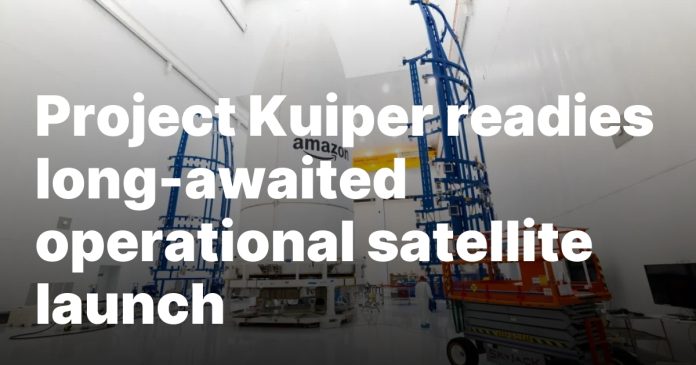Amazon announced Tuesday its first batch of operational Project Kuiper satellites will launch April 9, marking a significant milestone for the company’s planned 3,200-satellite broadband constellation.
The launch, designated KA-01 (Kuiper Atlas 1), will carry 27 satellites aboard a United Launch Alliance Atlas V rocket from Cape Canaveral Space Force Station, Florida. The mission comes approximately one year behind Amazon’s original deployment schedule as the company works to meet regulatory deadlines.
According to Amazon, the operational satellites feature substantial upgrades over the two prototypes launched in 2023, including enhanced phased array antennas, processors, solar arrays, propulsion systems and optical inter-satellite links.
“We’ve done extensive testing on the ground to prepare for this first mission, but there are some things you can only learn in flight, and this will be the first time we’ve flown our final satellite design and the first time we’ve deployed so many satellites at once,” said Project Kuiper vice president Rajeev Badyal in a company blog post.
The satellites were built at Amazon’s facility in Kirkland, Washington. Following successful prototype testing last year, the company had initially planned to begin deploying operational satellites in the first half of 2024, with beta customer trials involving Verizon and Vodafone scheduled for later this year. Those trials have now been pushed to 2025, though Amazon has not commented on the cause of the delay.
Amazon faces a critical regulatory timeline, as FCC licensing rules require the company to deploy half its constellation by July 2026 and the remainder by July 2029.
Heavy Payload, Ambitious Schedule
ULA officials confirmed KA-01 will be the heaviest payload ever flown on an Atlas V, which will utilize its most powerful configuration — five solid rocket boosters plus the main booster — to deploy the satellites at an altitude of 450 kilometers.
The launch represents just the beginning of Amazon’s ambitious deployment plan. ULA is contracted for seven more Atlas V missions and 38 launches using its larger Vulcan Centaur rocket for Project Kuiper.
Tory Bruno, ULA’s CEO, recently projected approximately a dozen launches this year for Amazon and other customers, split between Atlas V and Vulcan — the latter recovering from an anomaly during its second flight in October.
Amazon’s multi-billion-dollar launch arrangement also includes three SpaceX Falcon 9 missions, 18 Ariane 6 launches from Arianespace, and up to 27 New Glenn rockets from Blue Origin.
However, launch vehicle availability may present challenges. Arianespace projects only four more flights this year for its next-generation Ariane 6 rocket, which completed its first commercial flight in March. Blue Origin expects the next flight for New Glenn as soon as late spring, following an investigation into the failed booster landing on its inaugural flight.
“Our next launch will be on another Atlas V, and we’re already shipping and processing satellites for that KA-02 mission,” an Amazon spokesperson said via email. “We’ll share more details closer to launch. Overall, we plan to continue to pick up our pace of operations from here, and we’re on track to begin delivering service to customers later this year.”
In addition to its U.S. partnerships, Amazon has secured its first Asian distribution agreement. Japan’s Sky Perfect JSAT and Nippon Telegraph and Telephone Corporation have partnered to sell Project Kuiper services to Japanese businesses and government organizations.
